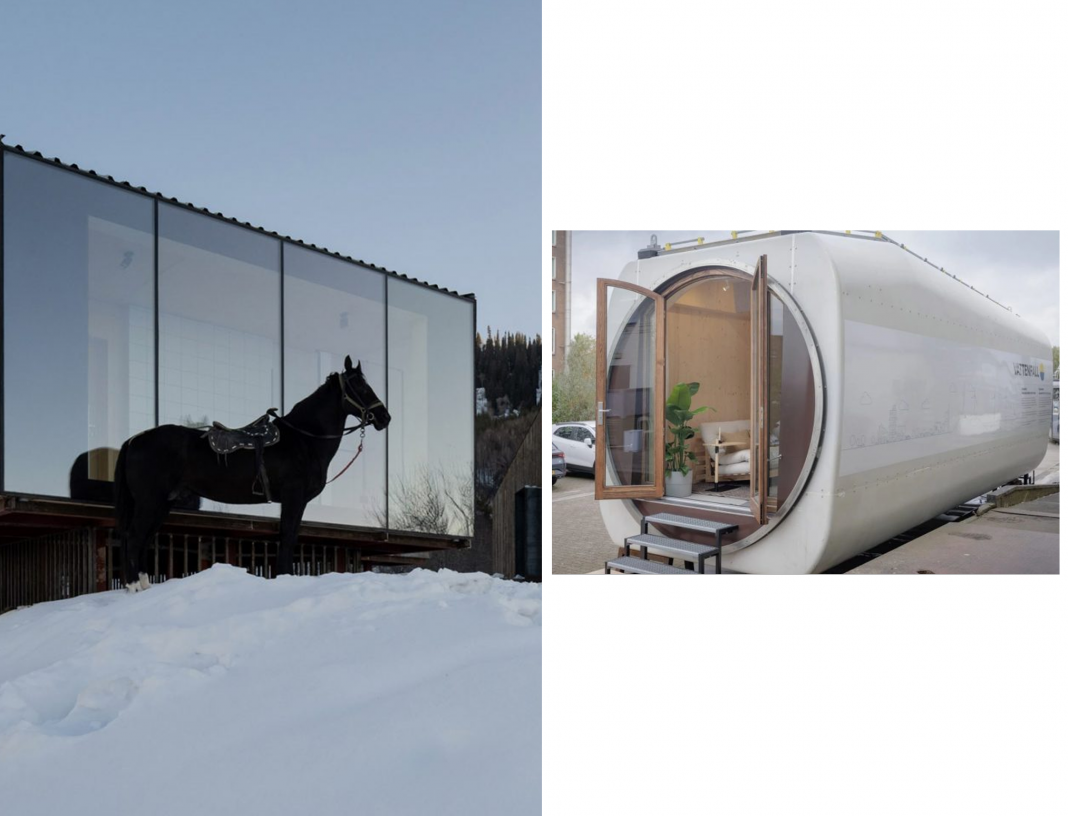This week in architecture and design, innovation took center stage—from a wind turbine reborn as a micro home to subtle yet symbolic rebrands by tech giants. As the Venice Architecture Biennale continued to spark global dialogue, we also spotlighted surreal houses, museum transformations, and the latest design trends shaping our built environment.

A home inside a wind turbine
One of the most unexpected and imaginative projects revealed this week was a prototype micro home built within a decommissioned wind turbine. Created by Dutch studio Blade-Made, the tiny timber-lined dwelling demonstrates a compelling new direction for circular design. Rather than letting turbine blades become industrial waste, the project reimagines them as architecture—practical, cozy, and poetic.
This home is just one of four concepts commissioned by Swedish energy provider Vattenfall and the Dutch Design Foundation as part of a research initiative exploring how wind energy infrastructure can be sustainably repurposed. Tucked inside the curved shell of a former blade, the micro home speaks to a future where the afterlife of renewable technology is just as thoughtful as its operation.
Major brands refresh iconic logos
In branding news, two of the world’s most recognizable logos received subtle but telling updates. Google introduced a refined version of its trademark G, blending its once-crisp primary colors into a seamless gradient. This evolution marks the first change in a decade and reflects the tech giant’s shift toward more fluid, integrated digital experiences.
At the same time, Amazon gave its iconic “smile” logo a minimalist makeover—the first in twenty years. The revision pares down the smile to its essential form, signaling a move toward a more restrained, contemporary aesthetic. While the core identity remains intact, these quiet changes illustrate how even the most recognizable brands feel the need to stay visually agile in a fast-evolving landscape.

Biennale buzz: Gold Lions and big ideas
Reporting continued from the Venice Architecture Biennale, where big ideas and bold installations continued to draw attention. Two standout projects—Diller Scofidio + Renfro’s Canal Cafe and the Bahrain national pavilion—took home the prestigious Golden Lion awards, each celebrated for their conceptual rigor and spatial storytelling.
We also explored key themes from the main exhibition, which focused on future-focused urbanism, climate resilience, and inclusive design. Highlights included robotic installations that challenged architectural conventions and a candid conversation with Norman Foster, who offered strong critiques of touchscreen-heavy car dashboards—an unexpected but relevant intersection of architecture, design, and technology.
Rotterdam’s new migration museum opens
Another significant architectural debut this week was the opening of the Fenix Museum of Migration in Rotterdam. Housed in a converted 16,000-square-meter industrial warehouse at the city’s harbor, the museum pays tribute to migration histories while embodying adaptive reuse at its most dynamic.
Architectural consultants Bureau Polderman led the sensitive restoration of the historical structure, while a sculptural rooftop viewpoint by MAD Architects offers a striking contemporary contrast. The view platform is accessed via a pair of dramatic helical staircases that wind up from the museum floor to the roof, creating a physical and symbolic ascent through layers of human movement and memory.

Surreal homes and unexpected materials
This week, Dezeen also featured a roundup of the most extraordinary houses—dwellings that stretch the imagination and challenge conventional ideas of what a home can be. From stark, industrial monoliths to structures that appear lifted from dreamscapes, these residences blur the line between art and architecture.
Among the highlights: holiday cabins in Kazakhstan that harmonize with nature, an “unfussy and honest” home in New Zealand that prioritizes local materials, and the meticulous renovation of Ray Kappe’s Glass Ridge House in Los Angeles—a testament to mid-century modernism and architectural stewardship.
A spotlight on resin flooring
Rounding out the week’s content was our latest Lookbook, which showcased the creative potential of poured resin flooring in domestic interiors. Once mostly associated with industrial settings, resin has entered the residential design lexicon as a colorful, seamless, and durable material that offers bold visual impact.
From vivid greens to soft neutrals, the featured homes used resin to enhance spatial flow, add character, and reflect light in subtle ways. These interiors demonstrate how material choice can transform not only the surface but also the emotional atmosphere of a space.
From rethinking wind turbines as shelters to reshaping digital icons and physical museums, this week highlighted how designers across disciplines are questioning norms and pushing boundaries. As architecture and design continue to intersect with sustainability, technology, and identity, the message is clear: reinvention—whether of materials, spaces, or symbols is more vital than ever.



